I am attending the Campus Technology 2009 conference in Boston this week.
Today I attended two workshops in the ‘pre-conference’ track.
The first workshop was ‘M01: Maps on a Spreadsheet and Other Google Collaboration Tools’ given by Mark Frydenberg, from Bentley University. Mark lead us through a tour de force introduction to ‘all things Google’. The basic search function was glazed over in preference for the other applications available from Google Labs. We touched on the phone-based telephone look-up Goog-411, created a blog with Blogger, created a wiki with Sites, explored the personal portal iGoogle, explored Knol, learned how to use the RSS app Reader to keep an eye on the “World Live Web – what’s going on in the world ‘right now'”. We looked at Google Docs, including the word processor and the spreadsheet program. I was particularly blown away by some of the features in the spreadsheet app which I had no idea about before, including the ability to use a ‘live search’ function as well as using gadgets to help visualize the information… this was the ‘maps on a spreadsheet’ for which the workshop was named. We also investigated iPhone apps that hook into Google information sources and allow access to Google Docs. At the half-way point I gave a brief demo of Google Wave, for which I have a Developer account. Mark and I logged in to my two developer accounts and showed the basics of how a Wave session can proceed.
The second session I attended was ‘M06: Web 2.0-enabled Interdisciplinary Collaborations: New Opportunities’ by Jim Wolfgang, Director, Digital Innovation Group, Georgia College & State University, and Keith Politte, Manager, Technology Testing Center, Reynolds Journalism Institute, Missouri School of Journalism. This session was an experiential encounter with the concepts behind collaboration. In the workshop we broke into groups and were then lead through exercises examining the meaning of collaboration and ways and tools that can be used to work in a collaborative fashion. We collaboratively developed a wiki page in support of our explorations. The two presenters did an excellent job of tag-teaming the topic and leading us through the exercises. They presented real-world examples of the collaborative projects embodied in their own work with the MU Interdisciplinary Innovations Fund and the Freshman iLife Competition. I came away from this session with a better understand of the diversity of opinion on ‘what is collaboration?’ and I am mulling over the possibilities of implementing some of these ideas myself.
Overall it was an excellent ‘pre-conference’ day, and I am eager to fill my brain with even more information and ideas in the coming three days for the remainder of the conference.
-marqueA2


